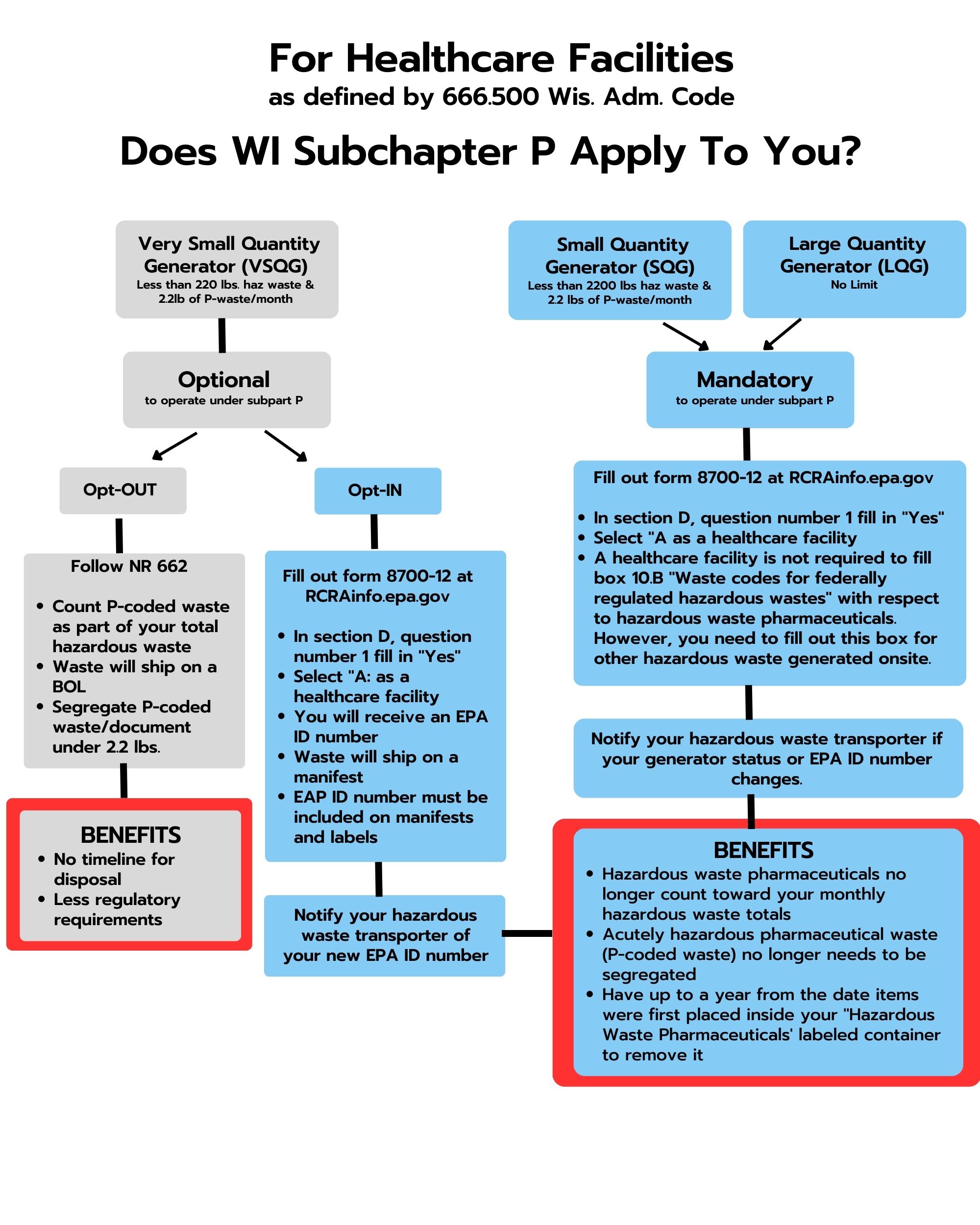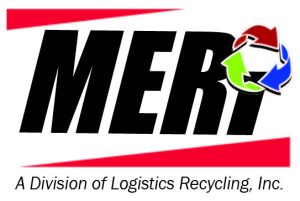WI Hazardous Pharmaceutical Rules
Wisconsin has adopted Subpart P of the federal Resource Conservation and Recovery Act (RCRA) for healthcare facilities. Reference the Department of Natural Resources (DNR) website for the most current and detailed information regarding the adoption of Subchapter P in Wisconsin.
Wisconsin DNR References for Hazardous Waste Pharmaceuticals:
WI DNR’s Hazardous Waste Pharmaceutical Rules
WI DNR Healthcare Facilities Definitions
Email us at info@meriinc.com if you have a specific question or would like to receive our blog updates.

Answers to Commonly Asked Questions:
Does My WI Healthcare Facility Need to Comply with the New Rules?
Your Wisconsin healthcare facility must comply with the new regulations if it:
– Provides care or services or procedures that affects mental or physical condition of humans or animal
– Distributes, sells or dispenses medicines, which pretty much covers all:
- Hospitals
- Health Clinics
- Psychiatric and Substance Abuse Centers
- Ambulatory Services and Ambulatory Surgical Centers
- Physicians’ Offices
- Optical and Dental Providers
- Chiropractors
- Veterinary Clinics and Hospitals
- Long-Term Care Facilities (administer pharmaceuticals to one or more individuals there)
- Pharmacies (including Mail-Order and Long-Term Care)
- Retailers of Pharmaceuticals
- Wholesale Distributors
- Third Party Logistics Providers that serve as forward distributors
Large and Small Quantity Generators are Required to Operate under Subpart P
You must operate under the EPA’s Subpart P program in Wisconsin if you are a:
- Large Quantity Generator (LQG): Generate more than 2,200 lbs. of hazardous waste per month.
- Small Quantity Generator (SQG): Generate more than 220 lbs. of hazardous waste, but less than 2,200 per month.
- Reverse Distributor: Those who receive or take back prescription pharmaceuticals from another organization to verify a manufacturer’s credit.
You can choose to opt in if you are a VSQG
- Very Small Quantity Generator (VSQG): Generate less than 220 lbs. of hazardous waste each month.
- VSQGs can continue to follow their previous way of handling their pharmaceuticals and acutely hazardous P waste. Otherwise, they may either opt into Subpart P, or send their hazardous waste pharmaceuticals off to an affiliate site that operates under Part 266 Subpart P.
Sewer Ban - No Flushing Hazardous Waste Pharmaceuticals
DO NOT flush hazardous pharmaceuticals down the drain or toilet
The nationwide Sewer Ban keeps hazardous pharmaceutical waste out of waterways.
These five DEA controlled substances are also hazardous waste pharmaceuticals. You must manage them in compliance with DEA regulations. Also, they must be destroyed to meet the DEA’s non-retrievable standards:
- Chloral/Chloral Hydrate (Acetaldehyde, Trichloro, Aquachloral, Noctec, Somnote, Supprettes)
- Fentanyl sublingual spray (Subsys)
- Phenobarbital (Bellergal-S Donnatal Luminal)
- Testosterone gels/solutions (Androgel Axiron Foresta, Testim)
- Valium gel/injectable (Diazepam, Diastat)
Make DEA Substances Non-Recoverable Before Destruction
MERI healthcare customers must following the DEA’s recommendations for making DEA substances non-recoverable before destruction. For example, it must go through a Cactus Sink or RX destroyer (with a DEA registrant witness) before MERI comes to collect it for hazardous disposal
What Does "RCRA Empty" Mean?
“RCRA Empty” Means:
- A container is empty when all of the medicine is visible removed.
- Dispose of P-listed waste containers (Warfarin, Coumadin, etc.) as non-credible, hazardous waste. No matter the amount of remaining residue.
- Put Non-acute pharma waste containers (syringes, IV bags, bottles, blister packs) in the trash or other other facility protocol.
- Manage unused or partially unused inhalers as hazardous waste.
- Empty, non-acute materials can go in the trash.
Nicotine Amendment: Do's and Don'ts
Nicotine Amendment
DO:
- Dispose of Liquid Nicotine as a P-Listed Hazardous Waste
- Follow your facility’s special disposal guidelines for Vape Pens and Cartridges
DON’T:
- Over the Counter Nicotine Patches, Gums and Wrappers can now be thrown in the trash
(Although, at MERI, we recommend you dispose of them as hazardous waste)
New Standards For Managing Hazardous Waste Pharmaceuticals
WI Rules for Handling Hazardous Waste Pharmaceuticals For Those Operating Under Subchapter P:
- Employees Handling Hazardous Waste Must Go through Training
- Facility Must have a Spill Response program that documents the management and containment of hazardous waste
- Both hazardous and non-hazardous can be managed as hazardous waste for incineration
- All sorting must take place at generator’s facility (reverse distributor can’t take it away to sort elsewhere)
Credible or Potentially Credible Hazardous Waste Pharmaceuticals
- Must Be in Original Packaging (1 year expiry date) for Reverse Distributor
- No manifest or land band required, but must keep shipping records for 3 years
- Must follow DOT shipping requirements, with tracking, delivery confirmation
- Contact Reverse Distributor if not received paperwork after 35 days
Non Credible Hazardous Waste Pharmaceuticals
- Don’t send non-credible waste to Reverse Distributor
- Containers must be structurally sound, compatible contents, secured, lid closed. Containers Must be labeled “Hazardous Waste Pharmaceuticals”
- Mark start date on container (Dispose one year after first item was placed in the container)
- Maintain a log or inventory system
- No satellite accumulation area requirements for hazardous pharmaceuticals
- Manifests initiated after Sept. 1, 2020 must use the “PHRM” waste code for non-creditable hazardous waste pharmaceuticals. If you did not note this code, you need to revise the manifests. This will prevent confusion and potential enforcement when evaluating e-manifest data against annual reporting. Generators can make this revision in EPA’s e-manifest system. Go to the DNR manifest page for instructions on registering to use e-manifest.
Operating under Subchapter P
Operating Under Subchapter P
- While you need to account for all hazardous waste in facility, if you are following Subchapter P, hazardous pharmaceutical waste will not count toward your status
- Must notify WI DNR if your facility is following Subchapter P. You can do this by using form 8700-12 and submit annual report
- Your facility can accumulate hazardous waste pharmaceuticals for up to one year. But, you need to document your date when the first hazardous waste pharmaceutical was placed in the container. You can do this either by writing the date on the container, or keeping a log so you know when the container must be disposed.
SQG/LQG Required to Operate Under Subchapter P
- Small Quantity Generators – SQG (less than 2,200 lbs. hazardous month, 2.2 lbs P-waste)
– Because hazardous waste pharmaceuticals no longer count toward your status, you may drop to a VSQG - Large Quantity Generators – LQG (no limited on hazardous waste)
– Because hazardous waste pharmaceuticals no longer count toward your status, you may drop to SQG or VSQG if opting into Subchapter P
VSQG Can Opt into Subchapter P
- Very Small Quantity Generators – VSQG – (less than 220 lbs. hazardous waste/mo; 2.2 lbs. P-waste)
– Can send both credible and non-credible to SQG or LQG that is under control of the same owner operating under Subchapter P
– Can decide not to opt into Subchapter P, but must follow NR 662, and have hazardous waste pharmaceuticals count toward your totals.
- Long Term Care Facilities – Follow 666.504-.506
– 20 or fewer beds presumed to be VSQG
– Allows for on-site receptacle from authorized DEA collector
– Drug Collection Devices (i.e. Drug Buster, RX Destroyer) Must Be Incinerated, and not put in the trash when full
What's a Solid Waste According to WI Regulations?
WI Solid Waste Rule
Check out how the WI DNR defines a solid waste.
Here’s our take: Material is a solid waste if you can no longer use it for its original purpose — and — you are getting rid of it by abandoning it, recycling it, or deeming it inherently waste-like.
In Wisconsin, the solid waste rule falls under NR 661.02. Items that don’t fall under this rule are those which are recycled, as per regulations NR 661.02 and NR 661.04. Note that you must document hazardous waste items you are legitimately recycling, rather than disposing. One example of this is hand sanitizer. You’ll need to document that you are donating it to another organization, rather than disposing of it as a hazardous waste.
Disposing Solid Waste
Solid wastes and recyclables are the most common types of waste in the healthcare industry. These include things like non-contaminated PPE, which end up in a landfill. Or, they include things like packaging materials, which often end up at a recycling facility.
You should work closely with your waste hauler and disposal facility to determine how to evaluate, profile and deliver solid waste generated at your facility.
What’s Not a Solid Waste
Infectious, radiological, hazardous or universal wastes are not solid wastes. They must first be sent to licensed facilities for treatment before disposal.
Deciphering your Waste
Is the waste generated at your facility a solid waste? Biohazard or infectious waste? Hazardous waste? Your facility must determine its waste classification before disposal.
The WI DNR recommends that nonhazardous pharmaceuticals be disposed of by appropriately authorized incineration. This is regardless of their classification as hazardous or solid waste.
For more info: read our blog: https://www.meriinc.com/defining-wisconsins-solid-waste-rule/
Link to WI DNR Hazardous Waste Webinars
Link to EPA 8700-12
RCRAinfo.epa.gov
Here’s the link to RCRAinfo.epa.gov …and here are the instructions on how to complete the EPA’s 8700-12 form to notify them you’ll be operating under Subpart P:
Small and Large Quantity Generators
If you’ve yet to do so, notify the EPA you are a healthcare facility (form 8700-12). This information will be captured in your WI hazardous waste annual report (Due March 1). A healthcare facility is not required to fill box 10.B “Waste codes for federally regulated hazardous wastes” with respect to hazardous waste pharmaceuticals. However, you do need to fill out this box for other hazardous waste generated onsite. In section D, question number 1 fill in “Yes” and Select “A” as a healthcare facility.
Very Small Quantity Generators:
Healthcare facilities can send both credible and non-credible waste to SQG and LQG if it is under control of the same owner operating under Subpart P To opt in, fill out form 8700-12. In section D, question number 1 fill in “Yes”. Select “A” as a healthcare facility. Soon after, you will receive an EPA ID number from the EPA to include on manifests and labels.
Very Small Quantity Generators: EPA Link
EPA Requirements for Very Small Quantity Generators of Hazardous Waste
Small Quantity Generators: EPA Link
EPA Requirements for Small Quantity Generators of Hazardous Waste
Large Quantity Generator Requirements: EPA Link
Requirements for Large Quantity Generators of Hazardous
